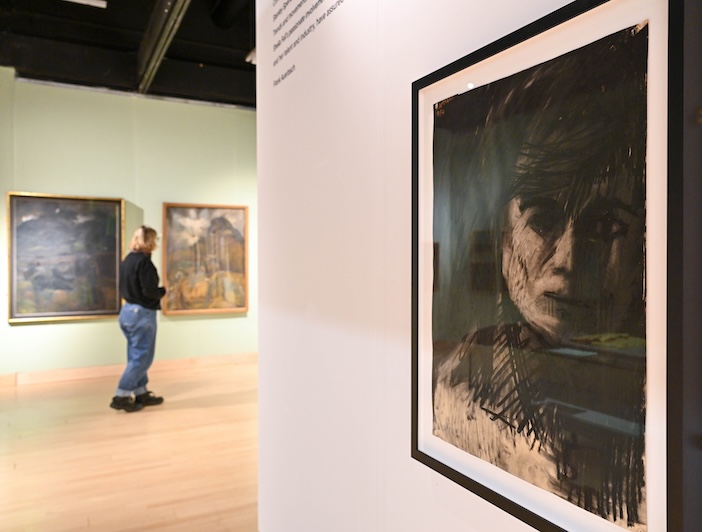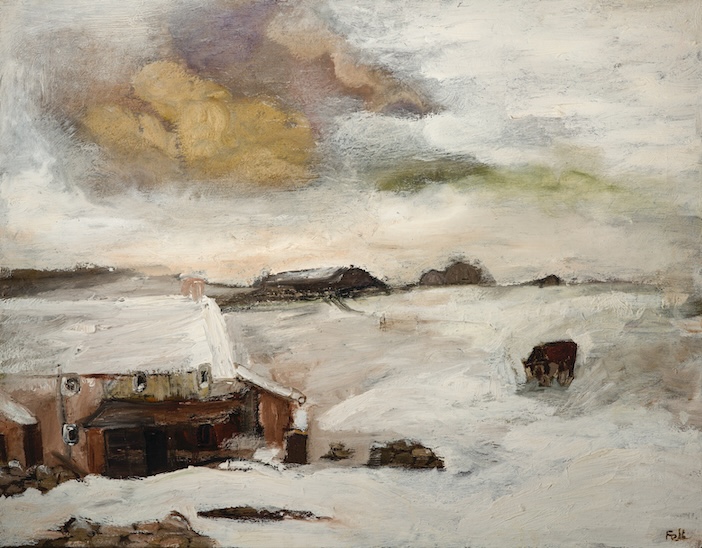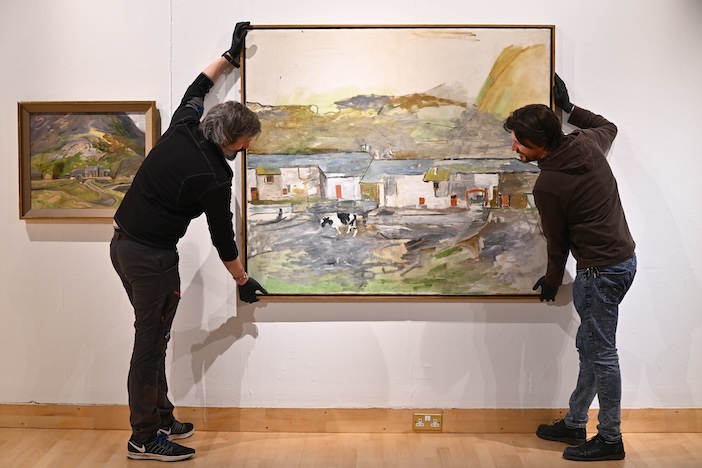It is fitting that the retrospective ‘Sheila Fell: Cumberland on Canvas’ of around 100 artworks by Cumbrian painter Sheila Fell RA (1931-1979) should be held at the Tullie, in Carlisle. It is the building that was formerly Carlisle College of Art where Fell studied to be a painter from 1948-1950. The artist, a dynamic figure in British art during the late 1950s to 1970s, is known for her enigmatic vision of Cumberland – its earthy landscape of mountains and fells, its villages, the agricultural land, the hill farms and livestock, and the Solway Firth. Sheila Fell captured in paint Cumberland’s unique heritage. I should add, the county of Cumberland changed its name to Cumbria in 1974, when it officially merged with Westmoreland.
Fell was born in Aspatria, a small town on the west coast of Cumberland, north of Maryport and Cockermouth, and south of Wigton and Carlisle. The location is relevant because the area around Aspatria features predominantly in her work. She grew up in a farming and mining community; her family’s heritage was farming until her grandfather became a miner, and her father, too. Her mother was a seamstress. While attending Thomlinson Girls’ Grammar School in Wigton her talent for drawing and painting was recognized and she gained a place at Carlisle College of Art in 1958.

Head of Sheila Fell, 1954, by Frank Auerbach.
Tutors advised her to focus on textile design, not painting, but Fell ignored the advice and continued to paint. From there she gained a place at St Martin’s School of Art in London, and it was then that she thought she might be a professional painter. The artist Frank Auerbach was a student there, too, and they would become lifelong friends. A superb portrait drawing by Auerback, Head of Sheila Fell, is in this Tullie exhibition.
After graduation, Fell took a teaching job at Chelsea School of Art and had a studio based in London. An interview with Fell, from Border TV in the 1960s, is telling in her comments, that at school she was initially more interested in colour than form and ‘sort of drifted into painting’. Working in London, her paintings of Cumberland were instigated through being homesick. She returned to Aspatria for several months each year, sketching outdoors, and later creating the paintings in her London studio. What is so special about her work is that she captured the essence of what her Cumberland was, not the tourism of the Lake District but the mood and sensation of living in the villages, walking along the coastline, or watching the skies change over precipitous hills. It can be bleak or beautiful, depending on the changeable weather. Anyone who has lived in Cumbria would recognise that perception.

Snowscape, Cumbria (Sheffield Museums Trust)
On view at Tullie, her paintings, Snowscape, Cumbria, from the late 1970’s, and 1967’s Haystack in a Field (main image) are two examples that portray the scene before her and the sensation of it, much like a landscape by Matisse. She stated that she had no interest in any painting that did not have its roots in reality. Fell’s favourite artists included Paul Cezanne, Chaim Soutine and Vincent van Gogh.
Her first public exhibition was at the Beaux Arts Gallery in London in 1955, the youngest artist to have a solo show there. One of the visitors was the Lancashire-born painter L.S. Lowry (1887-1976). Impressed with Fell’s work, he bought two paintings. The two became friends, with Lowry as patron and mentor, at times joining her to paint in Cumberland. Their friendship lasted until Lowry’s death in 1976.
Looking at Sheila Fell’s paintings, the early works are full of earthy browns, greys and greens – which were the cheapest paint pigments to buy – and Fell filled a canvas with thick paint in broad brushstrokes. Her use of brighter, more expensive paints came after she secured her teaching job. Fell’s potent style is evident in the artworks at Tullie, on loan from private collectors and public institutions. In 1974 Sheila Fell’s superb body of work was acknowledged by the Royal Academy of Arts and she was elected a Royal Academician.

Installing the painting that Fell was working on at the time of her death, the artwork has undergone extensive conservation by the Fine Art Restoration Company and is on loan from Castlegate House Gallery
Sheila Fell died, aged forty-eight, in December 1979. In an interview months before her death she stated that she wanted to do something new and planned to paint portraits of local people in Aspatria. In her last interview, with Hunter Davies for the Sunday Times, on the day before she died, Fell said she planned to live to 104, her head was so full of future paintings. One of her last works, a large unfinished painting, Untitled, of a Cumbrian farmyard, is in the Tullie show, and a 1979 photograph of Fell with this painting in the background was taken just before her death, indicating that she was working on it right up to her death.
The painting was rediscovered years later, housed in an outbuilding, and has since been restored, becoming one of the Tullie highlights of this first major retrospective in 30 years, celebrating the work of one of the twentieth-century’s greatest landscape painters.
‘Sheila Fell: Cumberland on Canvas’ runs at the Tullie in Carlisle until 16th March, 2025. For more information, please visit www.tullie.org.uk. The Catalogue Raisonne by the curators of the Tullie show, J. Andrew and Eleanor Bradley (from Lund Humphries, London), featuring 475 paintings, sketches and drawings, will be published in June 2025, and can be viewed at www.lundhumphries.com.
Main image: Haystack in a Field (image courtesy of the Tate). Photos by Stuart Walker.




